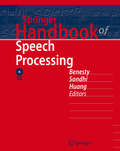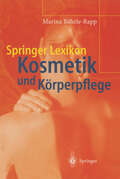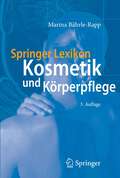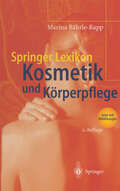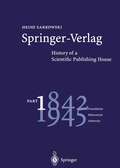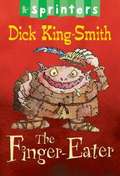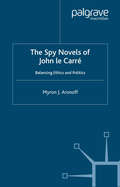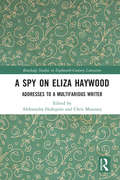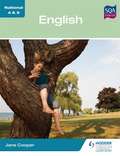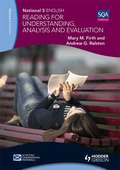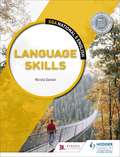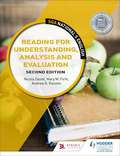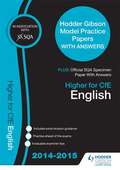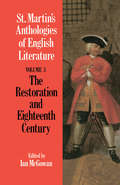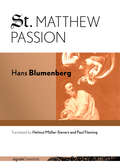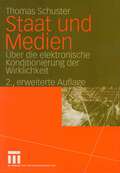- Table View
- List View
Spring and Autumn Annals of Wu and Yue: An Annotated Translation of Wu Yue Chunqiu
by Jianjun HeSpring and Autumn Annals of Wu and Yue is the first complete English translation of Wu Yue Chunqiu, a chronicle of two neighboring states during China's Spring and Autumn period. This collection of political history, philosophy, and fictional accounts depicts the rise and fall of Wu and Yue and the rivalry between them, the inspiration for centuries of poetry, vernacular fiction, and drama.Wu Yue Chunqiu makes use of rich sources from the past, carefully adapting and developing them into complex stories. Historical figures are transformed into distinctive characters; simple records of events are fleshed out and made tangible. The result is a nuanced record that is both a compelling narrative and a valuable historical text. As one of the earliest examples of a regional history, Wu Yue Chunqiu is also an important source for the history of what is now Zhejiang and Jiangsu.In Spring and Autumn Annals of Wu and Yue, Jianjun He's engaging translation and extensive annotations make this significant historical and literary work accessible to an English-speaking audience for the first time.
Springer Handbook of Speech Processing (Springer Handbooks)
by Jacob Benesty M. Mohan Sondhi Yiteng Arden HuangThis handbook plays a fundamental role in sustainable progress in speech research and development. With an accessible format and with accompanying DVD-Rom, it targets three categories of readers: graduate students, professors and active researchers in academia, and engineers in industry who need to understand or implement some specific algorithms for their speech-related products. It is a superb source of application-oriented, authoritative and comprehensive information about these technologies, this work combines the established knowledge derived from research in such fast evolving disciplines as Signal Processing and Communications, Acoustics, Computer Science and Linguistics.
Springer Lexikon Kosmetik und Körperpflege
by Marina Bährle-RappSystematisch und profund: mit über 11.300 Stichworten ein unverzichtbares Nachschlagewerk für die Bereiche Kosmetik, Visagistik, Haarpflege und Wellness und die PTA-Ausbildung. Es enthält alles für die qualifizierte Ausbildung und erfolgreiche Beratung inklusive einer Bewertung der kosmetischen Inhaltsstoffe. Für die 3. Auflage nahm die Autorin alles Wissenswerte rund um das Thema Haar neu auf. Zusätzlich aktualisierte und überarbeitete sie alle Begriffe grundlegend. Die Liste der Inhaltsstoffe entspricht nunmehr der EG-Kosmetik-Richtlinie (Stand 2006). Im selben Jahr erhielt die Autorin für ihre Leistung den Dr. Christine Schrammek-Preis.
Springer Lexikon Kosmetik und Körperpflege
by Marina Bährle-RappDie zweite Auflage des Lexikons Kosmetik und Körperpflege ... ... jetzt mit Abbildungen. ... mit vielen neuen Stichwörtern. ... alle Einträge grundlegend überarbeitet und aktualisiert. Mit über 10.000 Stichworten ist das vorliegende Buch ein unentbehrliches Nachschlagewerk für alle Bereiche der Kosmetikberatung. Fachbegriffe, kosmetische Inhaltsstoffe und relevante Krankheitsbilder werden auf verständliche Weise erläutert. Das Lexikon zeichnet sich aus durch: • Ausführliche Erklärungen und Bewertungen kosmetischer Inhaltsstoffe. • Umfassende Abhandlung der Bereiche Pflanzen und pflanzliche Inhaltsstoffe. • Separate Kennzeichnung natürlicher/biologischer Zusatzstoffe. • Übersetzung und Erläuterung der wichtigsten englischen und französischen Fachtermini. • Auflistung aller zur Zeit in Europa verwendeten kosmetischen Bestandteile und ihrer gültigen INCI-Bezeichnung. • Umfasst auch die Bereiche Nagelmodellage, Maniküre, Pediküre, Sonnenschutzmittel und Gerätekunde. • Viele Schmink- und Pflegetipps.
Springer-Verlag: Part 1: 1842–1945 Foundation Maturation Adversity
by Heinz SarkowskiThis book describes the fortunes and activities of one of the few specialist publishing houses still in the hands of the same family that established it over years ago, and with it gives a p- trayal of those members who directed it. In doing so it covers a period of momentous historical events that directly and in- rectly shaped the firm's actions and achievements. But this volume tells not only, in word and picture, the story of Springer- Verlag but also, interwoven with it, the story of scientific p- lishing in Germany over the span of a hundred years. The text, densely packed with carefully researched facts and figures, is illuminated and supplemented by many illustrations whose captions, together with the author's notes, contain a wealth of important and interesting information. The reader is urged to read these captions as well as the notes so as to - preciate in full the events and people described. I have added a few footnotes to clarify or expand on some matters that may be unfamiliar to non-German readers. Because of the long period of time covered in these pages many of the documents and letters shown and commented upon are different in diction and style from those of today. An - tempt was made in the translation to keep the flavour of the original language and not contemporise it.
Sprinters, Green: The Finger-Eater (New edition) (PDF)
by Dick King-SmithLong ago, in the cold lands of the North, there lived a troll named Ulf who had a very bad habit - he liked to eat fingers! Many, many men, women and children had found their hands a finger short thanks to the razor-sharp teeth of the Finger-eater. And who knows how many more might have suffered the same fate if it hadn't been for the actions of a resolute girl called Gudrun!
Sprinters, Green: The Finger-Eater (New edition) (PDF)
by Dick King-SmithLong ago, in the cold lands of the North, there lived a troll named Ulf who had a very bad habit - he liked to eat fingers! Many, many men, women and children had found their hands a finger short thanks to the razor-sharp teeth of the Finger-eater. And who knows how many more might have suffered the same fate if it hadn't been for the actions of a resolute girl called Gudrun!
Spuren des Geistigen: Die Macht des Mythos in Medien und Werbung
by Jana MagdanzDer Mythos ist eine menschheitsgeschichtlich uralte Denkgewohnheit, die in deutlichem Kontrast zur aktuellen wissenschaftlichen Welterklärung steht. Und doch deuten wir unsere Alltagswelt auch heute oft mythisch. Das Bedürfnis nach Mythen findet vor allem in den Medien eine Oase temporärer Befriedigung. Jana Magdanz zeigt auf, wie Medien mithilfe des Mythos zum Konsum verführen und besonders die Werbung urmenschliche Sehnsüchte mit dem Verlangen nach einem beworbenen Produkt verbindet. Mythische Symbole wie Götter und Helden, Archetypen wie Gestaltwandler und Schlange sowie verborgene narrative Strukturen erzeugen unzählige Identifizierungsoptionen für die Rezipienten und öffnen zugleich den Zugang zu ihrem Unterbewusstsein für maximale Werbewirkung. Der Mythos ist zu einem wichtigen, oft unbewusst angewandten Werkzeug der Medienschaffenden und Marketingabteilungen geworden. Die Autorin schlägt einen weiten Bogen von der theoretischen Verortung des Mythos, zeichnet das facettenreiche Bild seiner aktuellen Erscheinungsformen und untersucht zahlreiche aktuelle Werbebeispiele.
The Sputniks Crisis and Early United States Space Policy: A Critique of the Historiography of Space (Studies in Military and Strategic History)
by Rip BulkeleyAn examination of American space policy in the 12 years after World War II and in particular of the reaction provoked by the launching of the first Sputnik satellite in 1957. In the author's opinion the truth of what occurred in this period has been clouded by confusion and misinformation.
The Spy Novels of John Le Carre: Balancing Ethics and Politics
by M. AronoffUsing espionage as a metaphor for politics, John le Carré explores the dilemmas that confront individuals and governments as they act during and in the aftermath of the Cold War. His unforgettable characters struggle to maintain personal and professional integrity while facing conflicting personal, institutional, and ideological loyalties. In The Spy Novels of John le Carré , author Myron Aronoff interprets the ambiguous ethical and political implications of the work of John le Carré, revealing him to be one of the most important political writers of our time. Aronoff shows how through his writing, le Carré poses the difficult question of to what extent are western governments justified in pursuing raison d'état without undermining the very democratic freedoms that they claim to defend. He also draws parallels between the self-parody of le Carré and that of the seventeenth-century Dutch artist Jan Steen, and explains how it expresses a unique form of ambiguous moralism. In this volume Aronoff relates le Carré's fictional world to the real world of espionage, and demonstrates the need to balance the imperatives of ethics and politics in regard to some of the most pressing issues facing the world today.
A Spy on Eliza Haywood: Addresses to a Multifarious Writer (Routledge Studies in Eighteenth-Century Literature)
by Aleksondra HultquistEliza Haywood was one of the most prolific English writers in the Age of the Enlightenment. Her career, from Love in Excess (1719) to her last completed project The Invisible Spy (1755) spanned the gamut of genres: novels, plays, advice manuals, periodicals, propaganda, satire, and translations. Haywood’s importance in the development of the novel is now well-known. A Spy on Eliza Haywood links this with her work in the other genres in which she published at least one volume a year throughout her life, demonstrating how she contributed substantially to making women’s writing a locus of debate that had to be taken seriously by contemporary readers, as well as now by current scholars of political, moral, and social enquiries into the eighteenth century. Haywood’s work is essential to the study of eighteenth-century literature and this collection of essays continues the growing scholarship on this most important of women writers.
A Spy on Eliza Haywood: Addresses to a Multifarious Writer (Routledge Studies in Eighteenth-Century Literature)
by Aleksondra Hultquist Chris MounseyEliza Haywood was one of the most prolific English writers in the Age of the Enlightenment. Her career, from Love in Excess (1719) to her last completed project The Invisible Spy (1755) spanned the gamut of genres: novels, plays, advice manuals, periodicals, propaganda, satire, and translations. Haywood’s importance in the development of the novel is now well-known. A Spy on Eliza Haywood links this with her work in the other genres in which she published at least one volume a year throughout her life, demonstrating how she contributed substantially to making women’s writing a locus of debate that had to be taken seriously by contemporary readers, as well as now by current scholars of political, moral, and social enquiries into the eighteenth century. Haywood’s work is essential to the study of eighteenth-century literature and this collection of essays continues the growing scholarship on this most important of women writers.
The Spy Who Came in from the Cold (Modern Plays)
by John le CarreAll cats are alike in the dark.At the height of the Cold War, disillusioned British spy Alec Leamas is persuaded to stay out 'in the cold' for one last risky operation against the powerful leader of the East German Secret Service.But Leamas has committed a cardinal error: he's fallen in love. After a lifetime of deception and betrayal, can there be room for humanity in the ruthlessly manipulative world of international espionage?The first ever John le Carré novel to be adapted for the stage, this award-winning 1963 thriller has been hailed as a modern masterpiece. Leading playwright David Eldridge creates this gripping theatrical version.This edition was published to coincide with the world premiere at Chichester Festival Theatre in August 2024.
The Spy Who Came in from the Cold (Modern Plays)
by John le CarreAll cats are alike in the dark.At the height of the Cold War, disillusioned British spy Alec Leamas is persuaded to stay out 'in the cold' for one last risky operation against the powerful leader of the East German Secret Service.But Leamas has committed a cardinal error: he's fallen in love. After a lifetime of deception and betrayal, can there be room for humanity in the ruthlessly manipulative world of international espionage?The first ever John le Carré novel to be adapted for the stage, this award-winning 1963 thriller has been hailed as a modern masterpiece. Leading playwright David Eldridge creates this gripping theatrical version.This edition was published to coincide with the world premiere at Chichester Festival Theatre in August 2024.
SQA National 4 and 5 English (SQA National 4 & #5)
by Jane CooperEnsure your students are prepared for every aspect of their assessment with the only textbook endorsed by SQA and that offers fully comprehensive coverage of the new syllabus requirements. Written by a highly experienced author, it covers the new specification with all the new topics in the SQA examinations. The book provides thorough exam preparation, with graded Practice Exercises and is organised to make it easy to plan, manage and monitor student progress.
SQA National 5 English: Reading for Understanding, Analysis and Evaluation (PDF)
by Mary M Firth Andrew G. RalstonThis title is endorsed by SQA. Boost grades with quick and effective ways to acquire and improve the skill of reading for understanding, analysis and evaluation, which is worth 30% of the overall mark. This title offers guidance in one of the most important areas of National 5 English, in a skill area that some students believe 'cannot be practised'.
SQA National 5 English: Language Skills
by Nicola DanielExam Board: SQALevel: National 5Subject: EnglishFirst teaching: September 2017First exam: Summer 2018Successfully develop the key language skills that students must demonstrate across the National 5 English assessments. Covering reading, writing, talking and listening - vital skills for learning, life and work - this course companion helps students to fulfil their potential at N5 and beyond.- Introduces the language skills required for National 5 English, offering advice for studying and revising these skills throughout the school year- Focuses on strategies for approaching the RUAE and Scottish Texts sections of the exam, providing explanations of command words and different question types, worked examples and practice questions- Takes students step by step through the process of analysing an extract/passage, looking at word choice, imagery, structure and many other linguistic techniques- Improves every student's language skills, with dozens of ready-made and accessible activities, including independent work, group discussion points and extension tasks - with answers at the back of the book
SQA National 5 English: Reading for Understanding, Analysis and Evaluation: Second Edition
by Nicola Daniel Mary M. Firth Andrew G. RalstonExam Board: SQALevel: National 5Subject: EnglishFirst teaching: September 2017First exam: Summer 2018Offer the best possible preparation for National 5 English RUAE. Building students' confidence in reading unseen texts, this book focuses on the skills required for the exam before progressing to worked examples and full-length practice papers.- Teaches students how to answer every question type effectively and demonstrate their ability to understand ideas, analyse language and structure, and evaluate writers' techniques- Enables students to put their RUAE skills into practice as they tackle a range of short extracts and questions accompanied by active learning approaches, group work and individual tasks- Tests the skills that students have developed through six full-length passages and practice assessments, with answers and marking guidelines at the back of the book for easy reference- Provides stretch and challenge opportunities, including extension activities and further reading that will broaden students' Reading for Understanding, Analysis and Evaluation skills
SQA Specimen Paper 2014 Higher for CfE English and Hodder Gibson Model Papers (PDF)
by SqaContains study skill advice, specimen question papers, model papers and answers.
St. Martin's Anthologies of English Literature: Volume 3, Restoration and Eighteenth Century (1160-1798) (Anthologies of English Literature)
by Palgrave Macmillan LtdThe selection of writing in this anthology brings alive the excitement, wit, and exuberance of the Restoration and eighteenth century.
St. Matthew Passion (signale|TRANSFER: German Thought in Translation)
by Hans BlumenbergSt. Matthew Passion is Hans Blumenberg's sustained and devastating meditation on Jesus's anguished cry on the cross, "My God, my God, why have you forsaken me?" Why did this abandonment happen, what does it mean within the logic of the Gospels, how have believers and nonbelievers understood it, and how does it live on in art? With rare philological acuity and vast historical learning, Blumenberg unfolds context upon context in which this cry has reverberated, from early Christian apologetics and heretics to twentieth-century literature and philosophy. Blumenberg's guide through this unending story of divine abandonment is Johann Sebastian Bach's monumental Matthäuspassion, the parabolic mirror that bundled eighteen hundred years of reflection on the fate of the crucified and the only available medium that allows us post-Christian listeners to feel the anguish of those who witnessed the events of the Passion. With interspersed references to writers such as Goethe, Rilke, Kafka, Freud, and Benjamin, Blumenberg gathers evidence to raise the singular question that, in his view, Christian theology has not been able to answer: How can an omnipotent God be so offended by his creatures that he must sacrifice and abandon his own Son?
St Paul's Cathedral Precinct in Early Modern Literature and Culture: Spatial Practices (Early Modern Literary Geographies)
by Roze HentschellPrior to the 1666 fire of London, St Paul's Cathedral was an important central site for religious, commercial, and social life in London. The literature of the period - both fictional and historical - reveals a great interest in the space, and show it to be complex and contested, with multiple functions and uses beyond its status as a church. St Paul's Cathedral Precinct in Early Modern Literature and Culture: Spatial Practices animates the cathedral space by focusing on the every day functions of the building, deepening and sometimes complicating previous works on St Paul's. St Paul's Cathedral Precinct in Early Modern Literature and Culture is a study of London's cathedral, its immediate surroundings, and its everyday users in early modern literary and historical documents and images, with special emphasis on the late sixteenth and early seventeenth centuries. It discusses representations of several of the seemingly discrete spaces of the precinct to reveal how these spaces overlap with and inform one another spatially, and argues that specific locations should be seen as mutually constitutive and in a dynamic and ever-evolving state. The varied uses of the precinct, including the embodied spatial practices of early modern Londoners and visitors, are examined, including the walkers in the nave, sermon-goers, those who shopped for books, the residents of the precinct, the choristers, and those who were devoted to church repairs and renovations.
St Paul's Cathedral Precinct in Early Modern Literature and Culture: Spatial Practices (Early Modern Literary Geographies)
by Roze HentschellPrior to the 1666 fire of London, St Paul's Cathedral was an important central site for religious, commercial, and social life in London. The literature of the period - both fictional and historical - reveals a great interest in the space, and show it to be complex and contested, with multiple functions and uses beyond its status as a church. St Paul's Cathedral Precinct in Early Modern Literature and Culture: Spatial Practices animates the cathedral space by focusing on the every day functions of the building, deepening and sometimes complicating previous works on St Paul's. St Paul's Cathedral Precinct in Early Modern Literature and Culture is a study of London's cathedral, its immediate surroundings, and its everyday users in early modern literary and historical documents and images, with special emphasis on the late sixteenth and early seventeenth centuries. It discusses representations of several of the seemingly discrete spaces of the precinct to reveal how these spaces overlap with and inform one another spatially, and argues that specific locations should be seen as mutually constitutive and in a dynamic and ever-evolving state. The varied uses of the precinct, including the embodied spatial practices of early modern Londoners and visitors, are examined, including the walkers in the nave, sermon-goers, those who shopped for books, the residents of the precinct, the choristers, and those who were devoted to church repairs and renovations.
Staat und Medien: Über die elektronische Konditionierung der Wirklichkeit
by Thomas SchusterIn Anbetracht der ständigen Ausweitung des Einflussbereichs der Massenmedien muss man sich die Frage stellen, ob das enorme Informationsangebot tatsächlich zur Herausbildung eines vielfältigen Meinungsspektrums führt oder ob die Nachrichten-Schwemme nicht vielmehr eine meinungsverflachende und betäubende Wirkung hat. Fest steht zumindest, dass die Möglichkeiten einer intendierten Wirklichkeitsverfälschung mit den modernen elektronischen Medien eine völlig neue Qualität erfahren haben.

